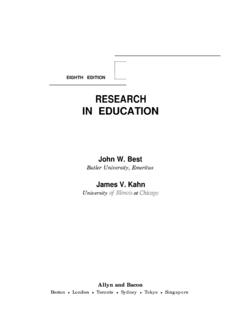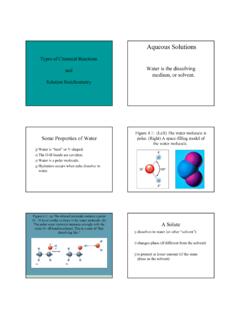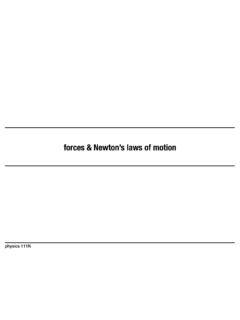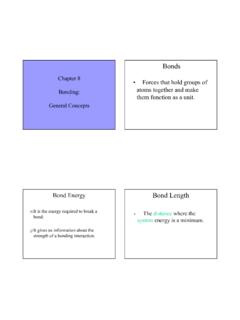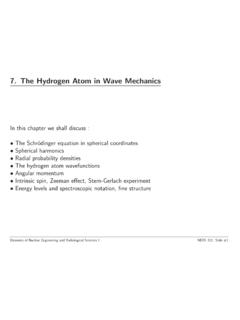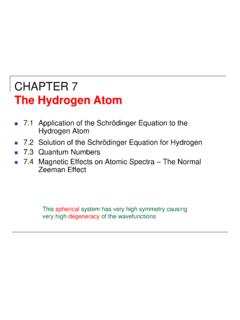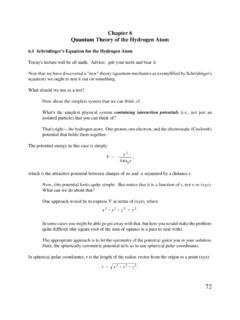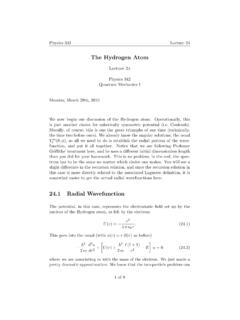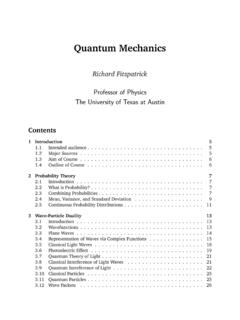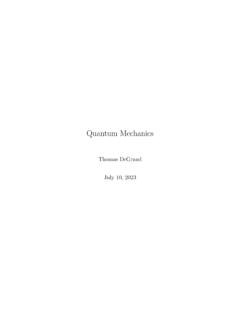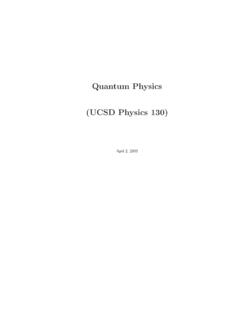Transcription of Quantum Mechanics Lecture Notes - Old Dominion University
1 Quantum MechanicsLecture NotesJ. W. Van OrdenDepartment of PhysicsOld Dominion UniversityAugust 21, 2007 Contents1 Introduction: The Old Quantum Classical Physics .. Thermodynamics and Statistical Physics .. Body Radiation .. Photoelectric Effect .. Atomic Physics .. Rays .. Decay .. Bohr-Sommerfeld Model .. Wave Particle Duality .. Scattering .. Diffraction ..172 Mathematical Background to Quantum Vector Spaces .. Scalar Product .. Notation .. Eigenvalue Problem.
2 The Continuum Limit ..313 The Schr odinger Wave Particle Duality .. Wave Packets .. The Schr odinger Equation .. The Interpretation of the Wave Function .. Coordinate Space and Momentum Space Representations .. Differential Operators .. The Heisenberg Uncertainty Relation .. Review of Classical Mechanics .. Generalization of the Schr odinger Equation ..574 The Time-Independent Wave Function61i5 Solutions to the One-Dimensional Schr odinger The One-dimensional Infinite Square Well Potential.
3 Bound States in a Finite Square Well Potential .. The One-Dimensional Harmonic Oscillator ..896 Scattering in One The Free-Particle Schr odinger Equation .. The Free Wave Packet .. The Step Potential .. 1057 The Solution of the Schr odinger Equation in Three The Schr odinger Equation with a Central Potential .. Harmonics .. The Radial Equation .. Solution of the Radial Equation for a Free Particle .. The Finite Spherical Well .. States.
4 Infinite Spherical Well .. The Coulomb Potential .. Wave Functions .. 1288 Formal Foundations for Quantum Review .. Dirac Notation .. Heisenberg Representation .. Matrix Representation .. 1409 Symmetries, Constants of Motion and Angular Momentum in Quan-tum Translations .. Time Translation .. Rotations .. of a Vector .. of Wave Functions .. The Angular Momentum Operators in Spherical Coordinates .. Matrix Representations of the Angular Momentum Operators.
5 Spin .. 1/2 .. Intrinsic Magnetic Moment of Spin-1/2 Particles .. Resonance .. 166ii10 Addition of Angular Introduction .. Addition of Two Angular Momenta .. General Properties of Clebsch-Gordan Coefficients .. Example: Addition ofj1= 1 andj2= 1 .. 18011 Rotation Matices and Spherical Tensor Matrix Representation of Rotations .. Irreducible Spherical Tensor Operators .. The Tensor Force .. The Wigner-Eckart Theorem .. 19212 Time-Independent Perturbation The Hydrogen Atom.
6 Perturbation Theory for Non-Degenerate States .. One-Dimensional Harmonic Oscillator in an Electric Field .. Degenerate State Perturbation Theory .. Leading Order Corrections to the Hydrogen Spectrum .. The Stark Effect .. 21813 Feynman Path The Propagator for a Free Particle .. 22814 Time-Dependent Perturbation The Interaction Representation .. Transition Matrix Elements .. Time-Independent Interactions .. Gaussian Time Dependence .. Harmonic Time Dependence.
7 Electromagnetic Transitions .. Classical Electrodynamics .. Quantization .. 24315 Many-body Systems and Spin The Two-Body Problem .. The Pauli Exclusion Principle .. The Permutation Operator .. in a Potential Well .. When is symmetrization necessary? .. The Fermi Gas .. The Bulk Modulus of a Conductor .. The Deuteron .. Isospin .. A Simple Model .. The Nucleon-Nucleon Potential .. 27116 Scattering The Scattering Cross Section.
8 The Optical Theorem .. Partial waves and Phase Shifts .. The Low-Energy Limit .. Scattering from a Spherical Well .. 283ivChapter 1 Introduction: The Old QuantumTheoryQuantum Mechanics is the physics of matter at scales much smaller than we are ableto observe of feel. As a result, we have no direct experience of this domain of physicsand therefore no intuition of how such microscopic systems behave. The behavior ofquantum systems is very different for the macroscopic systems of Classical this reason, we will begin by considering the many historical motivations forquantum Mechanics before we proceed to develop the mathematical formalism inwhich Quantum Mechanics is expressed.
9 The starting point is to review some aspectsof classical physics and then to show how evidence accumulated for atomic systemsthat could not be explained in the context of classical Classical PhysicsWhat we now call Classical Physics is the result of the scientific revolution of thesixteenth and seventeenth centuries that culminated in Newtonian Mechanics . Thecore of this physics is Newton s laws describing the motion of particles of matter. Theparticles are subject to forces and Newton s Second LawF=macan then be usedto describe the motion of the particle in terms of a second-order differential specifying the position and velocity of the particle at some initial time, the motionof the particle is determined at all subsequent time.
10 There is nothing in principle inclassical physics that prevents the initial conditions from being determined to arbi-trary accuracy. This property that allows all subsequent motion to be predicted fromNewton s Laws, the force laws and the initial conditions is called classical causality and classical physics is said to be deterministic since the motion is determined by theinitial major direction of physics after Newton was to incorporate as much physicalphenomena as possible into the framework of Newtonian physics. Thus Newton s lawswere applied to the motions of extended objects, to the motion of fluids and elastic1bodies and to link Mechanics to thermodynamics by means of the global conservationof application, which will be of particular interest in this course, was the descrip-tion of wave motion in fluids and elastic materials.



